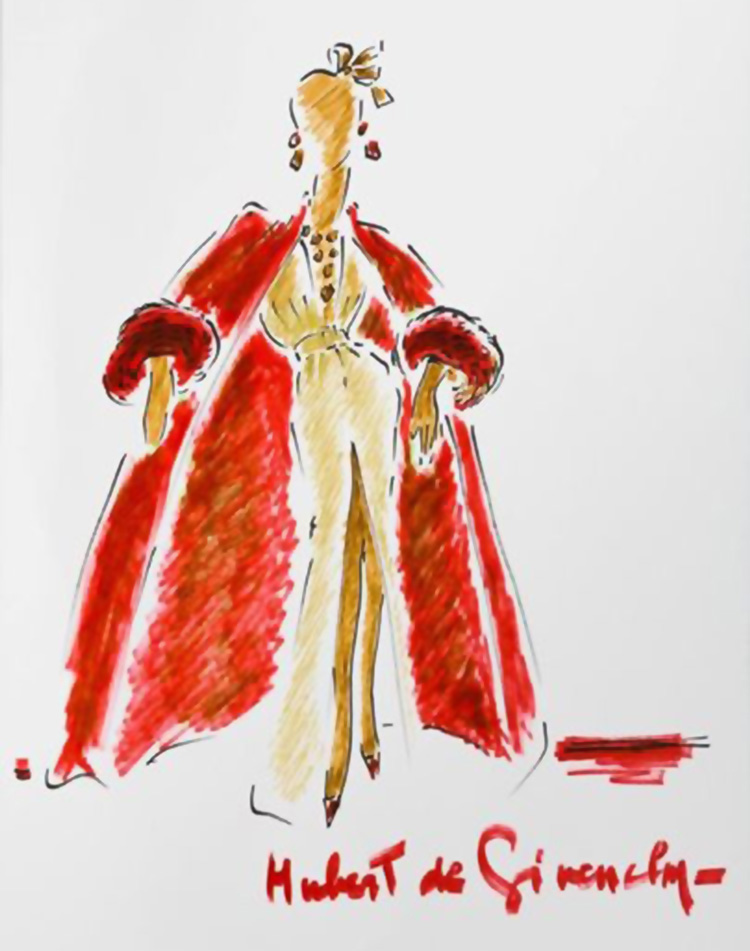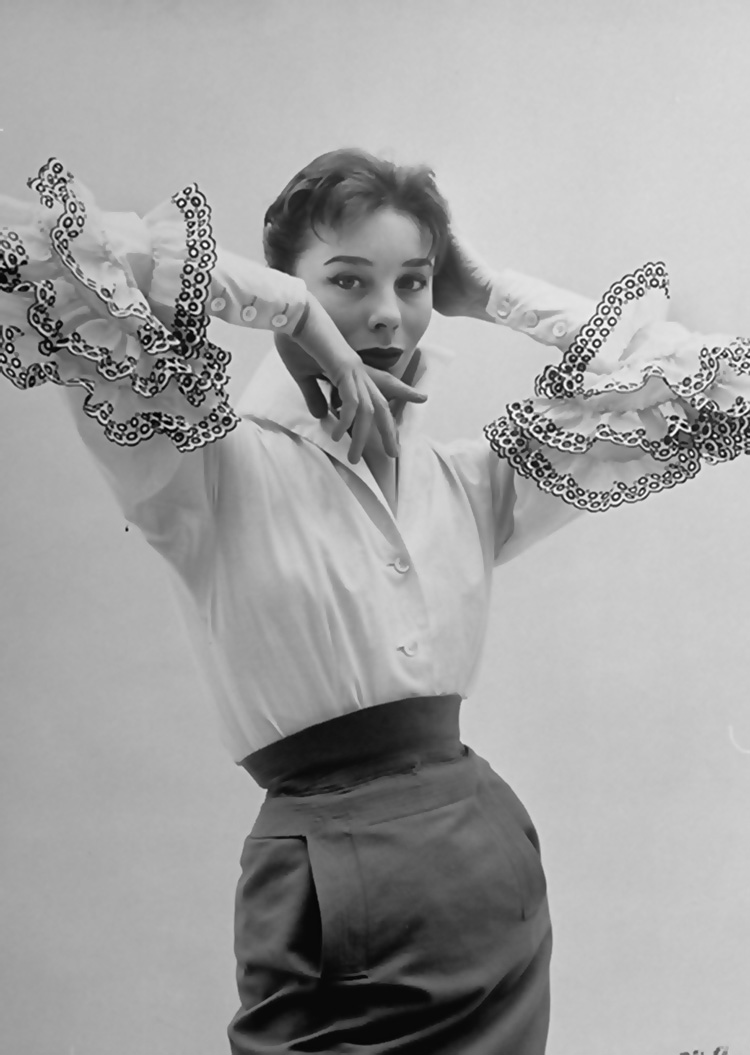From Audrey Hepburn’s little black dress to her wedding gown, Hubert De Givenchy is the master of iconic designs.

An illustration by Hubert de Givenchy
Although Givenchy is now a household name, Hubert founded the namesake brand in 1952 when he was in his 20s, quickly elevating the brand to become one of the most distinguished in Paris. Coco Chanel may have originated the Little Black Dress, but it was Givenchy, thanks to Audrey Hepburn’s both louche and devastatingly sharp inhabitation of an albeit-elongated version of the garment in Breakfast at Tiffany’s, that made it iconic.

Audrey Hepburn wearing Givenchy’s little black dress in Breakfast at Tiffany’s, 1961
Born on the 21st February 1927, in the provincial city of Beauvais, north of Paris, Hubert de Givenchy was raised by his mother and maternal grandparents after his father, a business executive and amateur pilot, died when he was a toddler. His grandfather, an administrator of a tapestry workshop in Beauvais, cultivated the young Givenchy’s appreciation of the arts and honed his aesthetic sensibility. After high school, he acceded to family pressure and joined a notary firm in Beauvais, but it didn’t last long, and he struck out for Paris in his late teens, in the wake of World War II.
Couturier Jacques Fath hired Givenchy on the strength of his sketches, and he spent two years learning the basics of fashion design, from sketching to cutting and fitting haute couture styles, while also studying drawing at the École Nationale Supérieure des Beaux-Arts, the French National School of Fine Art. He moved to Robert Piguet in 1946 and, briefly, Lucien Lelong in 1947 before joining Elsa Schiaparelli later the same year. Quickly, he became the Artistic Director of the Schiaparelli boutique at Place Vendôme.
In 1952, Givenchy founded his namesake house on Rue Alfred de Vigny in the 8th arrondissement of Paris, and it proved an instant success. No sooner did it open that it earned a reputation for breaking with fashion codes of its time. His debut collection ushered in the concept of separates, light blouses and skirts blending simplicity with architectural lines, as opposed to head-to-toe looks that were the norm among Paris couture purveyors. Working on a tight budget, Givenchy served up the floor-length skirts and country chic blouses in raw cotton materials normally reserved for fittings, including the high-buttoned, ruffled Bettina blouse which quickly took off during the ’50s. The collection’s body-conscious shapes created a sensation among the fashion press and buyers, especially because they were a stark contrast to the more restricted spirit of the time and the wasp-waisted, full-skirted ‘New Look’ pioneered by Dior.

Hubert de Givenchy
Since the inception of his eponymous brand in 1952, Givenchy had been an arbiter of glamour and sophistication, dressing the likes of Hollywood stars Greta Garbo, Lauren Bacall, and Grace Kelly. But perhaps his greatest and most fruitful relationship was the one he shared with lifelong client Audrey Hepburn. In the summer of 1953, the couturier met Hepburn, who borrowed several looks for her film Sabrina. It was the beginning of a long collaboration and profound friendship between the actress and the designer. The two quickly struck-up a friendship and their resulting working relationship went on to span 40-years, ending only on Hepburn’s death in 1993. In total, he dressed her for seven films, including Funny Face, Love in the Afternoon, Charade, and of course Breakfast at Tiffany’s, with the image of her in a simple black satin sheath dress with matching gloves and pearl necklace forming one of the most iconic images in cinematic and fashion history.
The common industry practice of celebrities as brand ambassadors, seen everywhere nowadays with global luxury brands and A-list movie stars, can be traced back to the Hepburn and Givenchy relationship. Her genuine friendship with Givenchy stemmed from his warm, gentleman’s persona and refined elegance, something they shared unequivocally. It’s quite rare this day and age to point out a designer-celebrity ambassador relationship that’s not tied to exclusive dealings and multimillion-dollar contracts.
Aiming to reach a wider market, Givenchy launched a line of upscale ready-to-wear and accessories in the 1960s, and its commercial success soon enabled him to buy out his backers, making him one of a handful of Paris couturiers to own their own label outright. However, in 1988, he sold the house to French luxury conglomerate LVMH Moet Hennessy Louis Vuitton, and went on to announce his retirement in 1995, leaving a great Haute Couture empire which underwent a series of changes at the creative director post.

Bettina Graziani wearing the Bettina blouse
The label was inherited first, from 1995 to 1996, by Hispanic-British designer John Galliano, one of the most controversial and famed fashion designers of the time who redefined the firm aesthetics. Galliano was followed by yet another legend in the industry, English fashion designer Alexander McQueen, who bestowed a vibrant and underground audacity from 1996 to 2000. Next was Welsh fashion designer Julien McDonald who brought a more commercial touch until 2005, when Italian designer Riccardo Tisci took over as creative director.
The longest-serving creative director, other than Givenchy himself, Riccardo Tisci helped grow the company exponentially thanks to his designs and celebrity support, bringing the brand into the modern red-carpet era, with stars from Beyoncé to Kim Kardashian becoming fans. In some ways, Tisci’s friendship with muse and social media phenomenon Kim Kardashian offers a parallel to the one Givenchy enjoyed with Hepburn, proving that an authentic relationship grounded in mutual respect and admiration can do wonders for a brand’s reputation and growth. Today English fashion designer Clare Waight Keller serves as Givenchy’s first female artistic director, following Tisci’s departure in 2017.
Sadly, on the 10th of March 2018, Monsieur de Givenchy passed away, leaving behind not only a thriving fashion house, but a legacy of his own. An aesthete and collector, Hubert de Givenchy symbolised Parisian chic and elegance for more than half a century and will always embody classic elegance with a touch of wit. His enduring influence and his approach to style reverberate to this day.
READ MORE
French Couturier Hubert de Givenchy Dies At 91
The Life And Legacy Of Alexander Mcqueen















